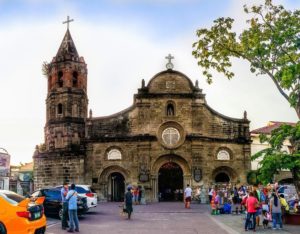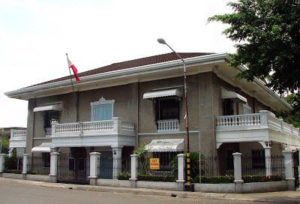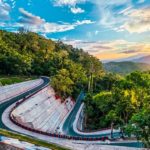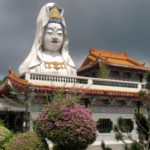My journey begins at the Barasoain Church, its baroque facade standing proudly against the azure sky. This isn’t just any church; this is where the First Philippine Republic was established in 1899, making it the cradle of democracy in Asia. The morning light filters through the stained glass windows, creating a kaleidoscope of colors on the worn wooden pews. A group of schoolchildren on a field trip files past, their excited whispers echoing off centuries-old walls that have witnessed pivotal moments in Philippine history.
The historic district of Malolos reveals itself as a photographer’s paradise. The ancestral houses along Pariancillo Street tell stories of Spanish colonial grandeur, their capiz shell windows and intricate woodwork speaking of a bygone era. I stop at Casa Real, once the seat of the revolutionary government, now transformed into a museum. The curator, an elderly gentleman named Manuel, shares tales passed down through generations about the Philippine Revolution with such vivid detail that I can almost hear the echoes of revolutionary meetings in these halls.
Moving beyond Malolos, I venture into Marilao, where the aroma of freshly baked pandesal leads me to a traditional bakery. The baker, Aling Azon, has been making bread here for four decades. “The secret,” she confides while pulling golden-brown rolls from a wood-fired oven, “is in the patience.” Her pandesal, warm and slightly sweet, melts in my mouth as she recounts how her grandmother taught her the craft during the American period.The afternoon finds me in San Miguel, home to the legendary Biak-na-Bato National Park. The network of caves and streams that once sheltered revolutionary forces now welcomes adventure seekers and history enthusiasts alike. My guide, Roberto, points out ancient rock formations while explaining how these caves served as natural fortresses during times of conflict. The cool mountain air carries the sound of rushing water, and somewhere in the distance, a kalaw bird calls out, its distinctive cry echoing through the limestone corridors.
In Bustos, I witness the marriage of history and modern necessity at the Angat Dam. This massive structure, while impressive in its own right, stands as a testament to how Bulacan has evolved while maintaining its agricultural heritage. The surrounding rice fields stretch to the horizon, their emerald expanse punctuated by farmers in wide-brimmed salakots tending to their crops, much as their ancestors did centuries ago.
The province’s culinary heritage proves equally compelling. In Bocaue, known as the fireworks capital of the Philippines, I find myself at a modest carinderia sampling local delicacies. The owner, Tita Beth, serves me puto Calasiao, soft rice cakes that virtually dissolve on the tongue, and the region’s famous chicharon, perfectly crispy pork rinds that have made Bulacan famous among food enthusiasts. “Every dish here tells a story,” she explains, placing a steaming bowl of beef pares before me. “This is how we keep our culture alive.”As evening approaches, I make my way to Obando, timing my visit with the famous fertility dance festival. Though it’s not the traditional May celebration, local dancers practice their steps in the church courtyard, their movements a unique blend of indigenous ritual and Catholic devotion. The setting sun paints the sky in brilliant oranges and purples, providing a dramatic backdrop to this display of living culture.
The day ends in Guiguinto, at one of the province’s numerous garden centers. Bulacan’s reputation as a horticultural haven is well-earned, with rows upon rows of ornamental plants creating a verdant maze. The owner, a third-generation plant cultivator named Antonio, explains how the industry has evolved from small family gardens to a major economic driver while maintaining traditional growing techniques.
What strikes me most about Bulacan is not just its historical significance or natural beauty, but how seamlessly the past and present interweave. In every town, ancient churches stand alongside modern developments, traditional industries adapt to contemporary demands, and cultural practices evolve while retaining their essential character.As night falls and the province’s lights begin to twinkle, I reflect on how Bulacan defies easy categorization. It’s neither stuck in the past nor rushing headlong into the future, but rather moving forward with a profound respect for its heritage. The province serves as a reminder that progress doesn’t require abandoning tradition – sometimes, the most meaningful developments are those that build upon the foundations laid by previous generations.
The cool evening breeze carries the distant sound of church bells, a sound that has marked time in these towns for centuries. Tomorrow, thousands of commuters will make their way to Manila for work, but tonight, in the quiet streets of Bulacan’s historic towns, it’s easy to imagine yourself in a different era, when revolutionary heroes walked these same paths and ordinary people made extraordinary history.
This journey through Bulacan reveals more than just tourist attractions or historical sites; it uncovers a living, breathing community that maintains its distinct identity while embracing change. For travelers seeking to understand the Philippines beyond its beaches and modern cities, Bulacan offers a unique window into the soul of the nation – a place where every street corner tells a story, and every meal carries the weight of tradition.As I prepare to depart, I understand why Bulacan holds such a special place in Philippine culture. It’s not just a collection of historical sites or a repository of traditions; it’s a dynamic community that demonstrates how a rich cultural heritage can serve as a foundation for growth rather than an obstacle to progress. In Bulacan, the past isn’t just preserved – it’s alive, evolving, and pointing the way toward the future.










Leave a Reply